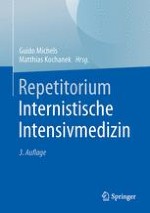
2017 | OriginalPaper | Buchkapitel
1. Intensivmedizinische Arbeitstechniken
verfasst von : G. Michels
Erschienen in: Repetitorium Internistische Intensivmedizin
Verlag: Springer Berlin Heidelberg

2017 | OriginalPaper | Buchkapitel
verfasst von : G. Michels
Erschienen in: Repetitorium Internistische Intensivmedizin
Verlag: Springer Berlin Heidelberg